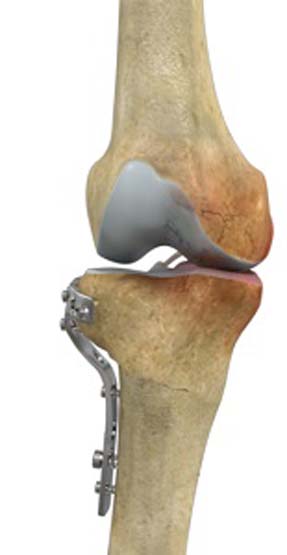
What is High Tibial Osteotomy?
High tibial osteotomy is a surgical procedure performed to relieve pressure on the damaged site of an arthritic knee joint. It is usually performed in arthritic conditions affecting only one side of your knee and the aim is to take pressure off the damaged area and shift it to the other side of your knee with healthy cartilage. During the surgery, your surgeon will remove or add a wedge of bone either below or above the knee joint depending on the site of arthritic damage.
Indications for High Tibial Osteotomy
High tibial osteotomy is commonly performed for osteoarthritis that is isolated to a single compartment (unicompartmental osteoarthritis). It is also performed for treating a variety of knee conditions such as gonarthrosis with varus or valgus malalignment, osteochondritis dissecans, osteonecrosis, posterolateral instability, and chondral resurfacing.
High Tibial Osteotomy Procedure
The goal of the surgery is to release the involved joint compartment by correcting the malalignment of the tibia and maintain the joint line perpendicular to the mechanical axis of the leg. There are two techniques that may be used: closing wedge osteotomy and opening wedge osteotomy. Your surgeon determines the choice of the technique based on your requirement.
Closing Wedge Osteotomy
Closing wedge osteotomy is the most commonly used technique. In this procedure, your surgeon makes an incision in front of the knee and removes a small wedge of bone from the upper region of the tibia (shinbone). This manipulation brings the bones together and fills the space left by the removed bone. Your surgeon then uses plates and screws to bind the bones together while the osteotomy heals. This procedure unloads the pressure off the damaged joint area and helps to transfer some of the weight to the outer part of the knee, where the cartilage is still intact.
Opening Wedge Osteotomy
In this procedure, your surgeon makes an incision in front of the knee, just below the kneecap and makes a wedge-shaped cut in the bone. Bone graft is used to fill the space of the wedge-shaped opening, and if required, plates and screws can be attached to further support the surgical site during the healing process. This realignment increases the angle of the knee to relieve the painful symptoms.
Complications of High Tibial Osteotomy
Complications following high tibial osteotomy may include infection, skin necrosis, non-union (failure of the bones to heal), nerve injury, blood vessel injury, failure to correct the varus deformity, compartment syndrome, and deep vein thrombosis or blood clots.
Related Topics:
- Knee Arthroscopy
- ACL Reconstruction
- Multiligament Reconstruction of the Knee
- Meniscal Surgery
- Cartilage Restoration
- Orthobiologics
- ACL Reconstruction with Patellar Tendon
- Partial Arthroscopic Meniscectomy
- Saucerization
- Intraarticluar Knee Injection
- Knee Fracture Surgery
- Arthroscopic Debridement
- LPFL Reconstruction
- Tibial Derotational Osteotomy
- Failed Meniscus Repair
- Meniscal Transplantation
- Meniscectomy
- Mosaicplasty
- Posterolateral Corner Reconstruction
- Prior Meniscectomy
- Quadriceps Tendon Repair
- Tibial Eminence Fracture
- Trochleoplasty
- ORIF of the Knee Fracture
- Chondroplasty
- Distal Femoral Osteotomy
- Hamstring Autograft
- Hamstring Allograft
- Viscosupplementation
- Physical Therapy for Knee
- Knee Osteoarthritis
- High Tibial Osteotomy
- Tibial Tubercle Osteotomy
- Patellar Tendon Repair
- Robotic Assisted Partial Knee Surgery
- Distal Realignment Procedures
- PCL Reconstruction
- LCL Reconstruction
- MCL Reconstruction
- Cartilage Replacement
- Bicompartmental Knee Resurfacing
- Autologous Chondrocyte Implantation
- Subchondroplasty
- Partial Meniscectomy
- Transphyseal Surgery
- Partial Transphyseal Surgery
- Medial Patellofemoral Ligament Reconstruction
- ACL Reconstruction Procedure with Hamstring Tendon
- Physeal Sparing Surgery (Anderson's Technique)
- Physeal Sparing Surgery (Micheli-KocherTechnique)
- Combined Hyaluronic Therapy for the Knee
- Matrix Induced Autologous Chondrocyte Implantation (MACI)
- Failed Anterior Cruciate Ligament (ACL) Reconstruction
- Physeal Sparing Reconstruction of the Anterior Cruciate Ligament
- Bone-Patellar Tendon-Bone (BPTB) Autograft
- Bone-Patellar Tendon-Bone (BPTB) Allograft
- Pharmacological Interventions for Knee Injuries
- Arthroscopic Reconstruction of the Knee for Ligament Injuries

